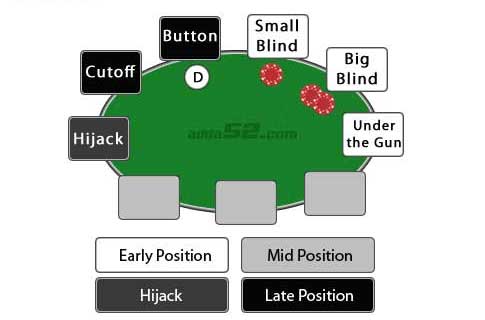In PLO, there are 16,432 different starting hands, which comprise all the possibilities resulting from the 270,725 stochastically possible combinations. So, how do you decide what starting hands to play and what not to play? This is why PLO has no clear-cut starting hand chart, unlike its popular cousin, Texas Hold’em. We at adda52 have tried our best to compile some of the top hands that are playable from all positions.
Top Pot-Limit Omaha Starting Hands
Below are the top 30 Omaha starting hands: (Note: All hands in the top 30 list must be double-suited.)
|
1. A-A-K-K |
11. K-Q-J-10 |
21. Q-Q-A-K |
|
2. A-A-J-10 |
12. K-K-10-10 |
22. Q-Q-A-J |
|
3. A-A-Q-Q |
13. K-K-A-Q |
23. Q-Q-A-10 |
|
4. A-A-J-J |
14. K-K-A-J |
24. Q-Q-K-J |
|
5. A-A-10-10 |
15. K-K-A-10 |
25. Q-Q-K-10 |
|
6. A-A-9-9 |
16. K-K-Q-J |
26. Q-Q-J-10 |
|
7. A-A-x-x |
17. K-K-Q-10 |
27. Q-Q-J-9 |
|
8. J-10-9-8 |
18. K-K-J-10 |
28. Q-Q-9-9 |
|
9. K-K-Q-Q |
19. Q-Q-J-J |
29. J-J-10-10 |
|
10. K-K-J-J |
20. Q-Q-10-10 |
30. J-J-10-9 |
However, the larger question for any poker player would be how to play the marginal hands, the run-downs, the one-gap hands, etc. To simplify this decision-making, we have marked down some starting hands and mentioned how they should be played in various positions. Unlike Texas Hold’em, where the starting hands are divided into three sections, PLO is a broader game with a wider choice. Thus, it is being discussed w.r.t Under the Gun (UTG), Middle position (MP), Cutoff (CO), Button (BTN) and Small Blind (SB). Visit our table positions page for more information.

Double Suited (DS) :- Four hole cards consisting of two sets of suited cards e.g. 4♥5♥7♠9♠.
Suited - Combination of cards of same suit e.g. - all Spades.
Rainbow - Combination of cards of different suit e.g. - 3♠5♥6♣A♦
Single Suited (SS) - Combination of cards with one pair of same suit e.g.- A♥3♥9♣J♦
|
Position |
Which starting hands to play? |
|
UTG |
A-A-K-K ds to A-A-2-2 ds, K-K-Q-Q ds to J-J-10-10 ds, K-K-9-9 ds to Q-Q-2-2 ds, J-J-9-9 ds to 8-8-7-7ds, A-A-K-K ss to A-A-2-2 ss, K-K-Q-Q ss to J-J-10-10 ss, K-K-9-9 ss to Q-Q-2-2 ss, J-J-9-9 to J-J-8-7 ss, A-A-K-K rainbow to A-A-2-2 Rainbow, K-K-Q-Q Rainbow to J-J-10-10 Rainbow, K-K-9-9 Rainbow to Q-Q-2-2 Rainbow, J-J-9-9 to J-J-8-7 Rainbow |
|
MP |
A-A-K-K ds to A-A-2-2 ds, K-K-Q-Q ds to J-J-10-10 ds, K-K-9-9 ds to Q-Q-2-2 ds, J-J-9-9 ds to 8-8-7-7ds, A-A-K-K ss to A-A-2-2 ss, K-K-Q-Q ss to J-J-10-10 ss, K-K-9-9 ss to Q-Q-2-2 ss, J-J-9-9 to J-J-8-7 ss, A-A-K-K rainbow to A-A-2-2 Rainbow, K-K-Q-Q Rainbow to J-J-10-10 Rainbow, K-K-9-9 Rainbow to Q-Q-2-2 Rainbow, J-J-9-9 to J-J-8-7 Rainbow, 8-8-6-6ds-5-5-3-3ds, J-J-7-7ds-10-10-2-2ds |
|
CO |
A-A-K-K ds to A-A-2-2 ds, K-K-Q-Q ds to J-J-10-10 ds, K-K-9-9 ds to Q-Q-2-2 ds, J-J-9-9 ds to 8-8-7-7ds, A-A-K-K ss to A-A-2-2 ss, K-K-Q-Q ss to J-J-10-10 ss, K-K-9-9 ss to Q-Q-2-2 ss, J-J-9-9 to J-J-8-7 ss, A-A-K-K rainbow to A-A-2-2 Rainbow, K-K-Q-Q Rainbow to J-J-10-10 Rainbow, K-K-9-9 Rainbow to Q-Q-2-2 Rainbow, J-J-9-9 to J-J-8-7 Rainbow, 8-8-6-6ds-5-5-3-3ds, J-J-7-7ds-10-10-2-2ds, J-7-7ss-10-10-2-2ss, 8-8-6-6ss-5-5-3-3ss, J-J-7-7ss-10-10-2-2ss
|
|
BTN |
A-A-K-K ds to A-A-2-2 ds, K-K-Q-Q ds to J-J-10-10 ds, K-K-9-9 ds to Q-Q-2-2 ds, J-J-9-9 ds to 8-8-7-7ds, A-A-K-K ss to A-A-2-2 ss, K-K-Q-Q ss to J-J-10-10 ss, K-K-9-9 ss to Q-Q-2-2 ss, J-J-9-9 to J-J-8-7 ss, A-A-K-K rainbow to A-A-2-2 Rainbow, K-K-Q-Q Rainbow to J-J-10-10 Rainbow, K-K-9-9 Rainbow to Q-Q-2-2 Rainbow, J-J-9-9 to J-J-8-7 Rainbow, 8-8-6-6ds-5-5-3-3ds, J-J-7-7 ds-10-10-2-2ds, J-7-7ss-10-10-22ss, 8-8-6-6-ss-5-5-3-3ss, J-J-7-7ss-10-10-2-2ss |
|
SB |
A-A-K-K ds to A-A-2-2 ds, K-K-Q-Q ds to J-J-10-10 ds, K-K-9-9 ds to Q-Q-2-2 ds, J-J-9-9 ds to 8-8-7-7ds, A-A-K-K ss to A-A-2-2 ss, K-K-Q-Q ss to J-J-10-10 ss, K-K-9-9 ss to Q-Q-2-2 ss, J-J-9-9 to J-J-8-7 ss, A-A-K-K rainbow to A-A-2-2 Rainbow, K-K-Q-Q Rainbow to J-J-10-10 Rainbow, K-K-9-9 Rainbow to Q-Q-2-2 Rainbow, J-J-9-9 to J-J-8-7 Rainbow, 8-8-6-6ds-5-5-3-3ds, J-J-7-7ss-10-10-2-2ss, 8-8-6-6ss-5-5-3-3ss, J-J-7-7ss-10-10-2-2ss |
How Pot-Limit Omaha Equity Affects You
In Omaha, the starting hand equities are more spread out when compared with a game at Texas Hold’em. For instance, in Texas Hold’em, the best starting hand, A-A, has almost 83% more equity than the second-best hand, KK. On the other hand, in a game of Omaha, the best-starting hand, A-A-K-K, has only 33% more equity to win against the second-best Omaha hand, A-A-J-10.
As you keep going lower in the starting hand rankings, the equity of the top hand keeps increasing, but this advance is relatively lesser than the equity that the top hand has compared to the same ranking lower hand in Texas Hold’em.
This spread in equities in Omaha leads to players having fewer chances of having a real edge against the players on the table. Rarely will there be a scenario where a player has more than 60% equity heads-up. As the number of players keeps increasing on the table, the equity drops drastically. Hence, it is very easy to see extreme swings in an Omaha game, even for an experienced winning player. Therefore, gaining an edge over others is possible even with slightly weaker hands.
To understand the amount of variance a player can experience in Omaha, let’s look at a similar example from a game of Texas Hold’em where one player is constantly going all-in during with A-K, and another player is calling with Q-T. Although A-K is a reasonably strong hand that will be profitable in the long run, yet 34% of the time, Q-T will win against that hand. This amount of probability in favour of the Q-T hand is enough to show a huge variance in their bankroll during the session for the other player with the A-K hand.
Plenty of opportunities exist for the players to complete draws in a game of Omaha. So, the players should use the following strategies:
- Choose Your Starting Hands Carefully: In Omaha, it is difficult to strengthen your case post-flop if you are not choosy about your starting hands.
- Value betting: Getting a clear-cut advantage over your opponents is tough and happens fewer times in Omaha. Hence, whenever you get such opportunities, you should be ready to cash in and resort to value betting.
- Cut losses: It is a crucial rule when playing poker to cut your losses small and go for large winnings.
What About Pre-Flop Raising in PLO?
Given that a player rarely has any serious edge over the other players, some argue that raising pre-flop in Omaha is unjustified as it leads to a higher variance. It makes sense to some extent, but this strategy will do no good to the player’s game in the long run.
On the contrary, if a player raises pre-flop even when they have a decently strong hand, it will always be beneficial to increase the size of the pot in the long run. The larger the sum the opponents put on the table when the player has an edge, the higher the chances of winning huge sums for the player. Not doing so will only eliminate the opportunities to win huge sums when the player has equity in hand.
A Final PLO Starting Hands Tip for Beginners
For players looking to build their Omaha game skills, knowing which hands to play and which ones to leave is important to avoid making bigger losses in the beginning stages. Hence, only play strong and very strong hands. Let go of all the weaker hands and spare yourself from making big losses. Only playing the top 30 hands mentioned in this article will help you save your bankroll while learning the game.
If a player starts playing weaker hands like A-K-2-6 when they are not fully prepared to do so, it will lead to a loss in bankroll and the player's confidence. Weaker hands, which are playable for beginners, can be connected cards like 8-9-10-J, which have higher chances of becoming strong hands post-flop. So, the tip to excel in Omaha is to leave the weaker and marginally strong hands.
Bad Hands to Avoid in PLO
-
Kings vs Aces in PLO is a Mistake
In Texas Hold’em, getting Aces as hole cards is difficult compared to getting Aces as hole cards in Omaha. Hence, having a King is considered good in Texas Hold’em, while having just kings in Omaha is not so good when you have already committed large sums of money.
Getting Aces is easy, with four cards being dealt in Omaha. Hence, while playing Kings in Omaha, you have to be extra careful during pre-flop unless the Kings are very strong, like A-K-K-Q or K-K-Q-J.
-
Big-Suited and Double-Suited Cards
In Omaha, the strong hands bring various benefits. While Big-suited cards and Double-suited hands might not consistently hit the top hands during the flop, they can result in strong two-pair combinations that can lead to strong full houses. Hands like A-K-J-10, A-Q-10-9, and K-10-J-9 are excellent hands, particularly when suited or double-suited.
For example, A-J-10-9 of the same suit or double-suited suit can stand out and could be preferable over a non-suited A-K-Q-J because it includes two suits, one of which is a nut suit. It is particularly valuable in Omaha because flush-over-flush scenarios are pretty common. Holding a nut suit allows you to beat smaller flushes, giving you a significant edge in play.
What Makes a Good Omaha Hand
To ensure a good hand at Omaha, you need to scrutinise your starting hands carefully and strictly. Many players get caught up in the rush and play way too much.
The difference between a pro player and a not-so-experienced player is that the pro player of Omaha knows how to differentiate between a good hand and a great hand while playing an intense game. So, a new player or a player on the learning curve starts figuring this out and parallelly identifying their strengths and weaknesses. Then, the game starts getting manageable for them, and they gradually start doing better.
Conclusion
Choosing your starting hands wisely is crucial when playing Pot Limit Omaha, as various possible hand combinations exist. Paying attention to playing strong hands, particularly the top 30 double-suited hands, helps to improve your chances of success in the game. As the equity between hands in PLO is closer than in Texas Hold’em, understanding the game’s unique dynamics can help manage your bankroll and minimize losses. Avoid playing weaker hands, and remember that patience and strategic decisions are key to becoming a better PLO player.
